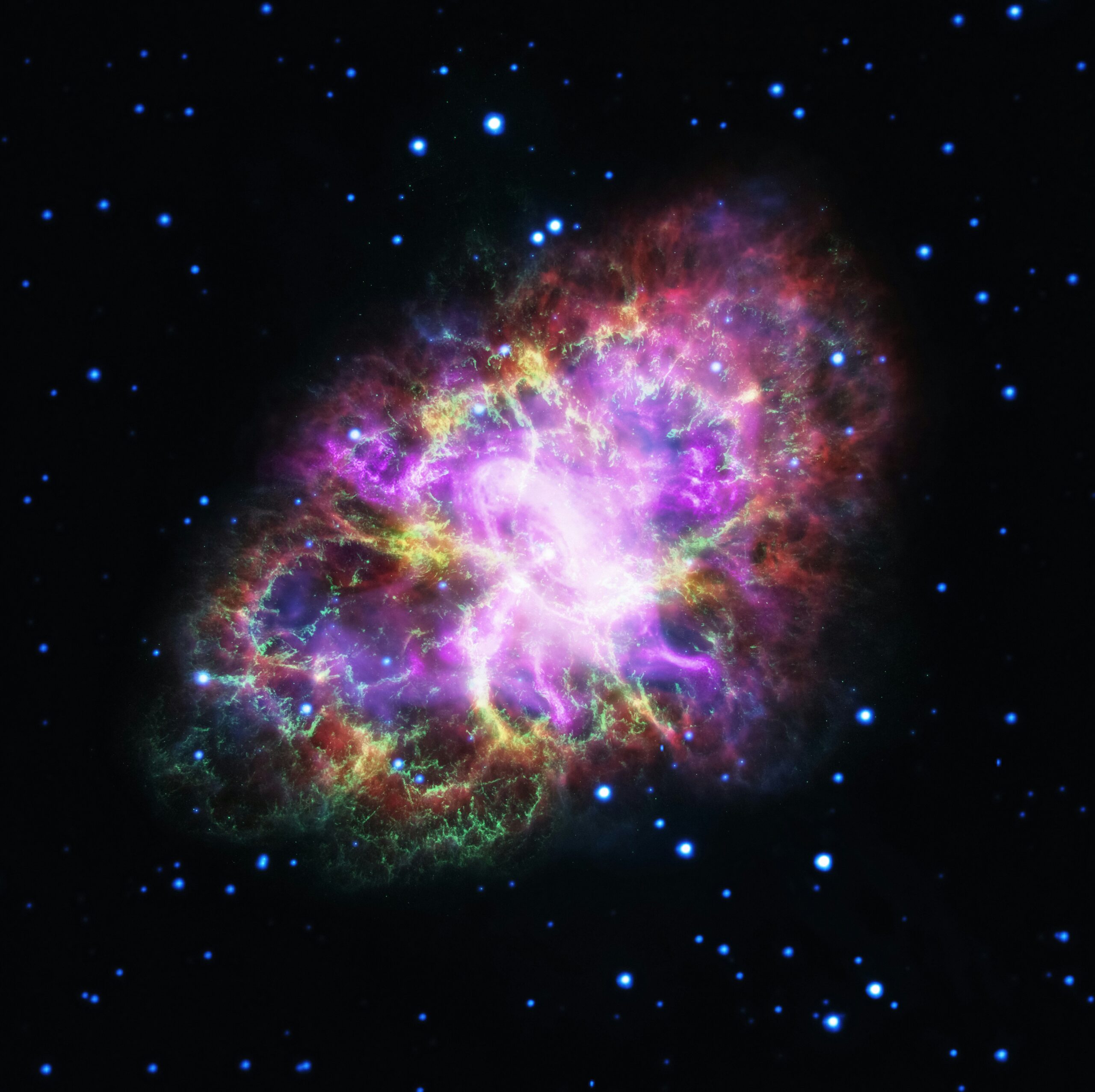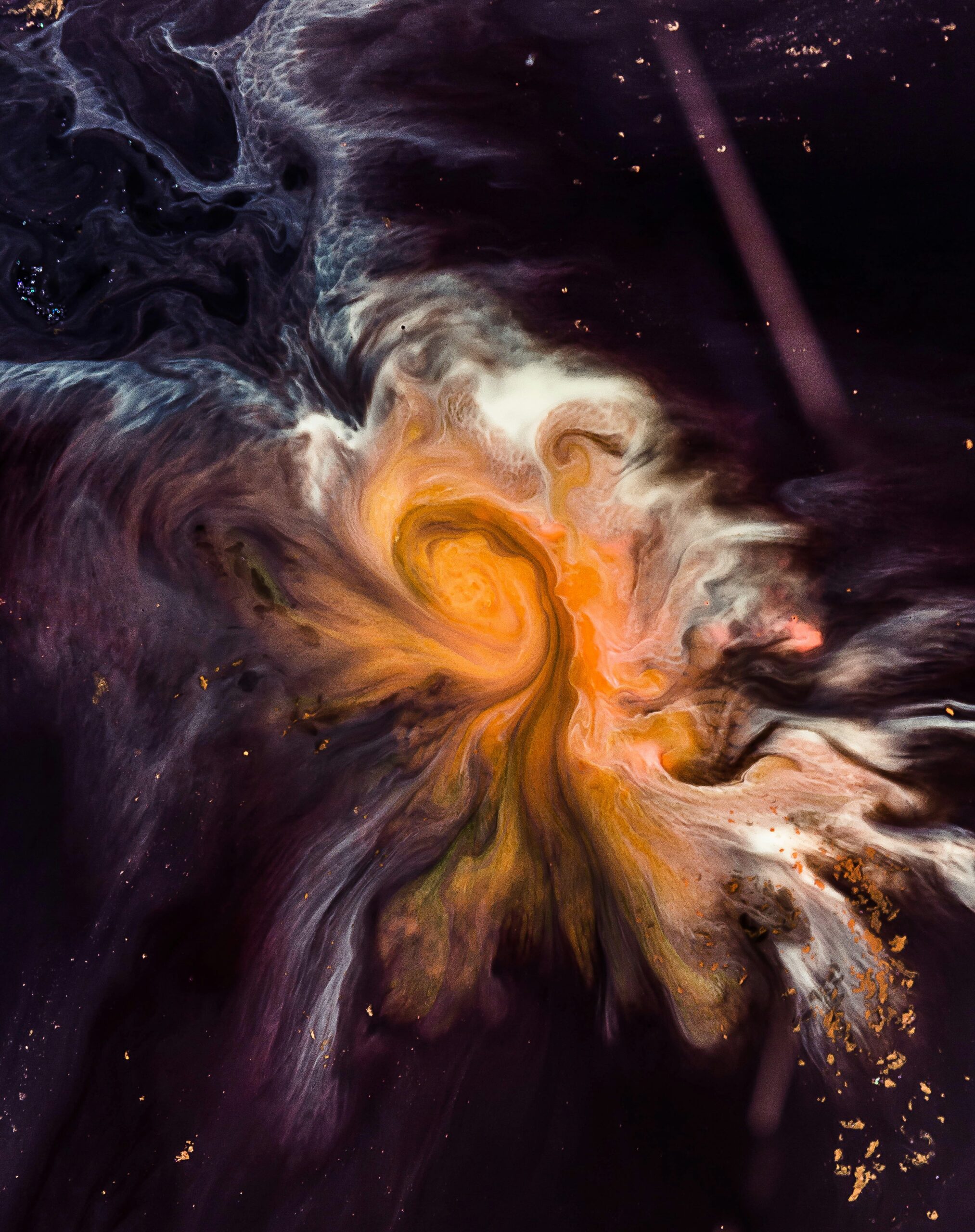Introduction to the Crab Nebula
The Crab Nebula, known scientifically as Messier 1 (M1), is one of the most studied and fascinating celestial objects in the night sky. Discovered by English astronomer John Bevis in 1731, it was later cataloged by Charles Messier in 1758 as the first object in his famous catalog of non-cometary objects. The Crab Nebula holds significant historical and astronomical importance due to its origins and the wealth of information it provides about cosmic phenomena.
Located approximately 6,500 light-years away from Earth in the constellation Taurus, the Crab Nebula is the remnant of a supernova explosion recorded by Chinese astronomers in 1054 AD. This cataclysmic event marked the death of a massive star, leaving behind a brilliant and expanding cloud of gas and dust that we observe today. The nebula spans around 11 light-years across and continues to expand at a rate of about 1,500 kilometers per second.
The Crab Nebula is not only a visual spectacle but also a crucial object of study for astronomers. Its complex structure includes filaments of ionized gas, which emit light across the electromagnetic spectrum, from radio waves to X-rays. At the heart of the nebula lies the Crab Pulsar, a rapidly rotating neutron star that emits regular pulses of radiation. This pulsar is a key feature, providing insights into the life cycle of stars and the dynamics of supernova remnants.
The Crab Nebula’s importance extends to various fields of astrophysics, including the study of particle acceleration, magnetic fields, and the behavior of interstellar matter. Its high-energy emissions and dynamic environment make it an ideal laboratory for understanding extreme physical processes in the universe. With the advent of advanced telescopes like the James Webb Space Telescope, our understanding of the Crab Nebula and similar astronomical phenomena continues to deepen, offering new perspectives on the origins and evolution of the cosmos.
The Legacy of Previous Observations
The Crab Nebula has captivated astronomers for centuries, with its first recorded observation dating back to 1054 AD by Chinese astronomers who documented a supernova explosion. This event left behind the nebula we observe today, making it one of the most studied remnants of a supernova. Early telescopic observations in the 18th and 19th centuries provided initial insights into its structure and composition. These early studies, though limited by the technology of the time, laid the groundwork for future astronomical investigations.
With the advent of more advanced telescopes, such as the Hubble Space Telescope, the Crab Nebula has been examined in greater detail. Hubble’s high-resolution images have revealed intricate filaments of gas and dust, providing a clearer picture of the nebula’s complex structure. These observations have shown that the Crab Nebula is expanding at a rate of about 1,500 kilometers per second, offering a dynamic perspective on the aftermath of the supernova explosion.
In addition to its structure, the composition of the Crab Nebula has been a focal point of study. Spectroscopic analysis has identified a rich array of elements, including hydrogen, helium, carbon, oxygen, nitrogen, and sulfur. These findings have deepened our understanding of the nucleosynthesis processes that occur during a supernova explosion. The nebula’s diverse chemical composition serves as a cosmic laboratory for studying the life cycles of stars and the synthesis of heavy elements in the universe.
Central to the Crab Nebula is the neutron star, often referred to as the Crab Pulsar. Discovered in 1968, this pulsar emits regular pulses of radiation, serving as a beacon in the nebula’s heart. Observations of the Crab Pulsar have provided crucial insights into the behavior of neutron stars, particularly their intense magnetic fields and rapid rotation rates. The pulsar’s powerful wind of charged particles is responsible for energizing the nebula, making it a unique astrophysical object of study.
Despite the wealth of information gathered, several questions remain. The exact mechanisms driving the pulsar wind and the detailed processes governing the nebula’s expansion continue to be subjects of active research. As new instruments and telescopes come online, such as the James Webb Space Telescope, astronomers anticipate uncovering even more about this enigmatic and fascinating remnant of a cosmic explosion.
Introduction to the James Webb Space Telescope
The James Webb Space Telescope (JWST) represents a significant advancement in astronomical observation, building upon the legacy of its predecessors like the Hubble Space Telescope. Launched with the goal of exploring the universe in unprecedented detail, JWST is equipped with cutting-edge technologies that enable it to observe the cosmos with remarkable precision. Unlike Hubble, which primarily operates in the visible and ultraviolet spectrums, JWST is designed to function primarily in the infrared range. This capability allows it to peer through cosmic dust and gas clouds that often obscure objects when viewed in other wavelengths.
The mission objectives of the James Webb Space Telescope are vast and ambitious. Among its key goals are the study of the formation of stars and planets, the examination of the physical and chemical properties of planetary systems, and the investigation of the origins of life itself. Its advanced instruments, including the Near Infrared Camera (NIRCam), Mid-Infrared Instrument (MIRI), and Near Infrared Spectrograph (NIRSpec), provide astronomers with the tools necessary to analyze the universe at a level of detail that was previously unattainable.
One of the primary reasons JWST is particularly suited for studying objects like the Crab Nebula is its exceptional infrared capabilities. The Crab Nebula, a remnant of a supernova explosion, is shrouded in dust and gas, making it challenging to study with telescopes that operate in other spectrums. The infrared sensors on JWST can penetrate this cosmic haze, revealing the underlying structures and dynamics of the nebula. This feature will enable scientists to gain new insights into the processes that govern the life cycle of stars and the formation of complex molecules in space.
In essence, the James Webb Space Telescope is poised to revolutionize our understanding of the universe. Its ability to observe in the infrared spectrum, combined with its suite of advanced instruments, makes it an invaluable tool for probing the mysteries of celestial objects like the Crab Nebula. As it embarks on its mission, JWST promises to open new windows into the cosmos, offering a deeper understanding of the universe’s origins and evolution.
New Insights from JWST Observations
The James Webb Space Telescope (JWST) has brought unprecedented clarity to the study of the Crab Nebula, a remnant of a supernova observed in 1054 AD. Utilizing its cutting-edge instruments, JWST has conducted detailed observations that are transforming our understanding of this enigmatic nebula. The telescope’s Near Infrared Camera (NIRCam) and Mid-Infrared Instrument (MIRI) are pivotal in these investigations. These instruments allow scientists to observe the Crab Nebula across a wide range of wavelengths, from the near-infrared to the mid-infrared spectrum.
JWST’s NIRCam is particularly adept at peering through the dense clouds of gas and dust that often obscure other telescopes’ views, revealing the inner structures of the nebula with remarkable precision. This capability is complemented by MIRI, which provides insights into the cooler regions of the nebula, where complex molecules and dust grains form. By combining data from these instruments, researchers can construct a comprehensive picture of the Crab Nebula’s composition and dynamics.
Preliminary data from JWST’s observations have already yielded intriguing findings. For instance, the telescope has detected unexpected patterns in the nebula’s infrared emission, suggesting the presence of previously unseen structures. These could represent regions where new star formation is occurring or areas where the supernova’s shock waves are interacting with surrounding material. Furthermore, JWST’s sensitivity to faint signals has unveiled subtle variations in the nebula’s chemical makeup, offering clues about the processes that shaped it over the past millennium.
JWST’s advanced observational capabilities enable scientists to explore the Crab Nebula in ways that were previously unimaginable. The detailed images and spectra obtained provide a window into the nebula’s past, present, and future, helping to unravel the mysteries of its origin and evolution. As the data continues to be analyzed, we can expect even more groundbreaking discoveries that will deepen our understanding of this fascinating celestial object.
Unraveling the Origins of the Crab Nebula
The Crab Nebula, a well-studied supernova remnant, has fascinated astronomers since its discovery. Various scientific theories have sought to explain its formation and origin, with the most widely accepted hypothesis attributing it to the supernova explosion observed by Chinese astronomers in 1054 AD. This explosion resulted in a pulsar at the nebula’s center, emitting radiation across the electromagnetic spectrum. However, questions surrounding the precise mechanisms of the explosion and the nebula’s subsequent evolution persist.
The James Webb Space Telescope (JWST) is playing a crucial role in shedding light on these mysteries. Equipped with advanced infrared imaging and spectroscopy capabilities, JWST allows scientists to peer deeper into the nebula than ever before. By examining the remnants and surrounding materials, researchers can gather valuable data on the composition, temperature, and movement of particles within the nebula. This information is essential for testing existing theories about the Crab Nebula’s formation and refining our understanding of supernova mechanics.
One key aspect that JWST’s observations are addressing involves the distribution of elements within the nebula. By analyzing the emitted light, astronomers can determine the presence and abundance of various elements, such as oxygen, carbon, and nitrogen. These findings help to confirm whether the nebula’s current state aligns with theoretical models of supernova remnants. Additionally, JWST’s ability to capture high-resolution images of the nebula’s intricate structures provides insights into the processes that shaped it over the centuries.
Understanding the origins of the Crab Nebula has broader implications for the study of stellar evolution. Supernovae are critical events in the life cycle of stars, contributing to the synthesis of heavy elements and the formation of new stars and planetary systems. By investigating the Crab Nebula, scientists can refine their models of how these explosive events unfold and their impact on the surrounding interstellar medium. This knowledge enhances our comprehension of the cosmos and the dynamic processes that govern its evolution.
The Role of Pulsars in the Crab Nebula
The Crab Pulsar, situated at the core of the Crab Nebula, is a highly magnetized, rotating neutron star that emits beams of electromagnetic radiation. Pulsars, a subset of neutron stars, are known for their remarkable precision in emitting radiation, akin to cosmic lighthouses. These objects are crucial in astrophysics due to their extreme environments, which allow scientists to study the behavior of matter and energy under conditions that cannot be replicated on Earth.
The James Webb Space Telescope (JWST) is playing a pivotal role in advancing our understanding of the Crab Pulsar. By leveraging its advanced instruments, JWST is capable of observing the pulsar across multiple wavelengths, providing unprecedented detail about its properties and interactions with the surrounding nebula. Through these observations, JWST has gleaned crucial insights into the pulsar’s magnetic field, rotation period, and the mechanisms behind its radiation.
One notable discovery made by JWST involves the pulsar’s interaction with the nebula’s magnetic field. The data reveals intricate patterns of energy transfer between the pulsar and the surrounding gas and dust, shedding light on the processes that sustain the nebula’s luminosity. Additionally, the telescope’s high-resolution imaging has unveiled previously unseen structures within the nebula, such as shock waves and filaments, which are directly influenced by the pulsar’s emissions.
Furthermore, JWST’s observations have provided a more comprehensive understanding of the pulsar’s wind—a stream of charged particles emanating from the neutron star. This particle wind plays a significant role in shaping the nebula’s structure and dynamics. By analyzing the wind’s composition and behavior, researchers can gain deeper insights into the life cycle of pulsars and their impact on their cosmic surroundings.
In essence, the Crab Pulsar serves as a natural laboratory for studying extreme astrophysical phenomena. The detailed observations made by JWST not only enhance our knowledge of the Crab Nebula but also contribute to the broader field of pulsar research, offering valuable clues about the fundamental physics governing these enigmatic objects.
Implications for Future Research
The findings from the James Webb Space Telescope (JWST) regarding the Crab Nebula have profound implications for the field of astrophysics. The advanced capabilities of JWST have provided unprecedented details about the structure, composition, and dynamics of this supernova remnant. These insights are likely to shape future research in several key areas, including supernova remnants, neutron stars, and the interstellar medium.
One of the primary implications is the enhanced understanding of supernova remnants. JWST’s high-resolution imaging and spectroscopy have revealed intricate details of the Crab Nebula’s filaments and shock waves. This data can help astrophysicists refine existing models of supernova explosions and their aftermath, leading to more accurate predictions of the life cycles of stars and the evolution of galaxies. Additionally, the precise chemical compositions detected by JWST can inform researchers about the nucleosynthesis processes that occur during a supernova event.
The study of neutron stars, the dense remnants left behind after a supernova, also stands to benefit significantly. JWST’s ability to observe the Crab Nebula in various wavelengths allows for a more detailed examination of the neutron star at its core. This can lead to a better understanding of the extreme physical conditions within neutron stars, such as their magnetic fields and the state of matter under immense pressure. These insights might even contribute to the ongoing quest to detect and study gravitational waves, which are generated by the interactions of neutron stars.
Furthermore, JWST’s observations have implications for the study of the interstellar medium (ISM). The Crab Nebula serves as a valuable laboratory for understanding how supernova remnants interact with the ISM, affecting its composition and dynamics. The detailed observations can help researchers explore the processes of dust formation and destruction, the enrichment of the ISM with heavy elements, and the role of supernova remnants in the galactic ecosystem.
These discoveries open up new avenues for research. Potential questions for future studies include the detailed mechanisms of particle acceleration in supernova remnants, the properties of neutron star atmospheres, and the long-term impact of supernovae on galactic chemistry. The JWST’s findings on the Crab Nebula are not just a milestone in astrophysics but a springboard for future exploration and discovery in the cosmos.
Conclusion: The Continuing Mystery
In summary, the James Webb Space Telescope (JWST) has provided unprecedented insights into the origins and characteristics of the Crab Nebula, unveiling details that were previously obscured. Through its advanced infrared capabilities, JWST has allowed scientists to peer deeper into the dense and turbulent regions of this enigmatic nebula, revealing intricate structures and complex interactions among its constituent elements. These observations have significantly enhanced our understanding of the Crab Nebula’s formation and evolution following the supernova explosion that created it.
Despite these advancements, many questions about the Crab Nebula remain unanswered. The exact mechanisms driving the nebula’s dynamic behavior, the full extent of its chemical composition, and the role of its central pulsar in shaping its morphology are still areas ripe for further investigation. The JWST’s findings have, in many ways, raised new queries even as they have provided answers, underscoring the labyrinthine nature of cosmic phenomena.
Continued study of the Crab Nebula is crucial for several reasons. Firstly, it serves as a natural laboratory for understanding the life cycles of stars and the processes that govern stellar explosions. Secondly, insights gained from the Crab Nebula can be extrapolated to other similar astronomical objects, enhancing our overall grasp of the universe’s complexity. Lastly, the ongoing investigation of such phenomena fuels the broader quest for knowledge, driving technological advancements and inspiring future generations of scientists and researchers.
The Crab Nebula remains a focal point of astronomical research, embodying both the progress we have made and the mysteries that still elude us. As we continue to explore and unravel the secrets of the cosmos, the data collected by the James Webb Space Telescope will undoubtedly play a pivotal role in shaping our understanding of the universe’s most fascinating and complex entities.


